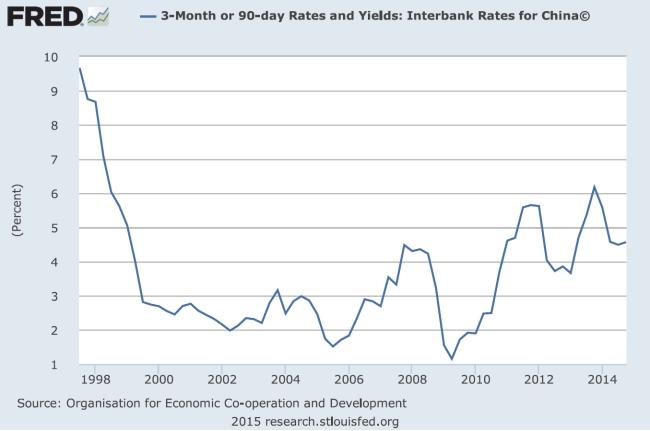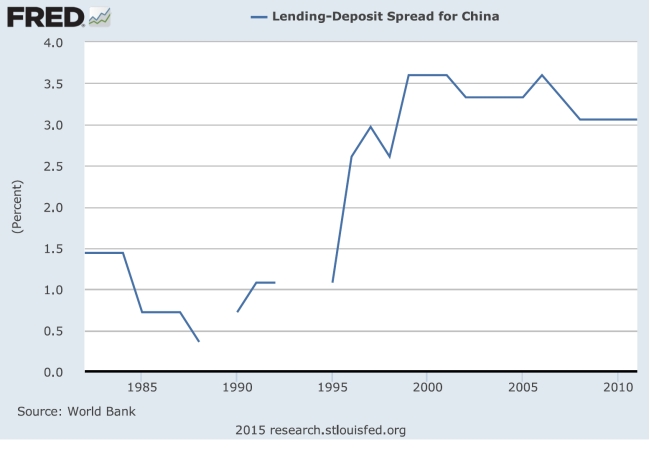Deck 8: Monetary Policy in Action
سؤال
سؤال
سؤال
سؤال
سؤال
سؤال
سؤال
سؤال

فتح الحزمة
قم بالتسجيل لفتح البطاقات في هذه المجموعة!
Unlock Deck
Unlock Deck
1/8
العب
ملء الشاشة (f)
Deck 8: Monetary Policy in Action
1
Go to FRED (the Federal Reserve Economic Database) and compare the Lending-Deposit spread with the ninety-day interbank interest rate (produce a graph to show the comparison). Explain why one is highly volatile and the other is relatively stable (period to period).




One is market determined (the first graph) and the other is a regulated (fixed) rate (second graph) determined by the People's Bank of China.
2
What is the main difference between the stated goals of the People's Bank of China (PBC) and the Federal Reserve Bank of the United States (the Fed).
For the Federal Reserve the main targets to control are output, unemployment, and inflation. For the PBC, though the wording has a certain ambiguity, the exchange rate appears to be a target along with output and inflation. China's exchange rate is not floating, so as we discuss in the chapter, monetary policy needs to be consistent with a quasi-fixed exchange rate. Controlling inflation is a necessary but not sufficient condition for controlling the exchange rate.
3
Why does China's PBC use so many tools to control the financial system compared to the Fed?
As we saw in Figure 8.1 (in the text), China has more targets (policy objectives) to control than what is found in the United States. Many (but not all) of these objectives center around the exchange rate and trade (which feedback into employment and reserve accumulation). In effect, China attempts to control both quantity and prices, but for a given demand curve, market forces would normally not allow both to be controlled. As a result, more tools are needed.
4
Eventually if China is to have a high degree of international capital mobility, explain what it will have to give up in terms of a key policy variable. Why?

فتح الحزمة
افتح القفل للوصول البطاقات البالغ عددها 8 في هذه المجموعة.
فتح الحزمة
k this deck
5
Go to the IMF's Annual Report on Exchange Arrangements and Exchange Restrictions (2013) (www.imf.org/external/pubs/nft/2013/areaers/ar2013.pdf) and identify how China's exchange rate regime is classified. Explain its regime classification with its monetary policy classification.

فتح الحزمة
افتح القفل للوصول البطاقات البالغ عددها 8 في هذه المجموعة.
فتح الحزمة
k this deck
6
In terms of the traditional capital structure theories for companies, explain how China's government policies and special economic circumstance may modify the conventional approaches to capital structure.

فتح الحزمة
افتح القفل للوصول البطاقات البالغ عددها 8 في هذه المجموعة.
فتح الحزمة
k this deck
7
Even though China does control international capital mobility, it still needs to undertake the increasingly difficult task of sterilization. Explain why China, in its efforts at controlling its exchange rate, has in effect lost a degree of control over its monetary policy. Discuss both the magnitude and volatility of exports as factors.

فتح الحزمة
افتح القفل للوصول البطاقات البالغ عددها 8 في هذه المجموعة.
فتح الحزمة
k this deck
8
Explain the traditional "transmissions mechanism" and why it is still a "work-in-progress" description of how monetary policy works in China.

فتح الحزمة
افتح القفل للوصول البطاقات البالغ عددها 8 في هذه المجموعة.
فتح الحزمة
k this deck








